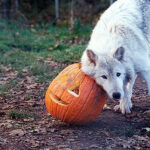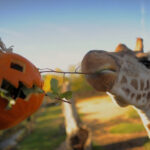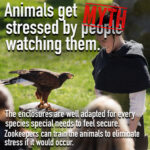Me and Ryer working on a “dive” behavior with the long target pole.
This is a good example of how the behaviors people often like to malign as ‘forced tricks’ are entirely voluntary. Look how eagerly Ryer waits for that cue and then dives for the target.
Cool thing I learned:
A lot of these “tricks” are actually to help provide quality care for animals in the least stressful way possible
For example, trainers at the Minnesota Zoo train bears to touch their noses to batons (much like the otter is doing in the video) so that zookeepers can examine the bears without handling them. Getting bears to turn their heads, stand on their hind legs, or turn around helps zookeepers get a good look at how the bears look and move (which is important to monitor their health).
Baton training also provides the most amount of safety to trainers as possible, and bears willfully play and enjoy the activities and the treats that come with them.
Baton training also helps bears get vaccinated. Without being distracted by an activity and willfully exposing their sides to the trainers, bears would have to be tranquilized to receive their immunizations. That puts a lot of stress on the bear’s body and can be a traumatic experience.
When bears are distracted and happy, zookeepers can give them a quick shot and the bear hardly notices!
So yeah training can be for purposes that benefit the animals, not just for entertainment. But training could also be an enrichment activity that offers mental stimulation.
This is such a great explanation of all the husbandry training that we do. Some examples of husbandry behaviors in disguise that we have:
Dive: it gives the otters exercise, and it could be used for future research such as breath holding time, how swimming effects heart rate, etc so that we can keep learning more about these animals and their physiology.
Retrieve or Fetch: looks like just fun, but it can actually be used for animal safety. If a foreign object gets into the exhibit we can ask them to retrieve it so we can safely remove it.
Full Body Tactiles (touching them full handed on their back): looks like we are just petting the otter and showing off how much trust we have (which like yes kinda but keep listening), but actually it allows us to check body condition and feel for any lumps or swelling on their back. It can be great early detection for tumors, spinal problems, and hidden scabs.
I work at a zoo and the keepers are incredible with training. It is so so useful. By being able to do more veterinary-related conscious, the less stressful it is for the animal.
Once, it was before i started but, they even managed to get a full blood sample from the tail of a conscious tiger – purely by using his training. Its not for fun or show, its genuinely makes it easier and less stressful for everyone/every animal involved.
Tag: Zoo
This is the spoopy content you need on your dash
This is so precious I can’t even…
Everybody loves pumpkin enrichment!
These are great items because they’re fun for the herbivores to each, the carnivores to tear apart, and everybody to roll and throw around. They’re tactile, olfactory, and edible enrichment all in one!
I believe they’re acceptable on-exhibit enrichment for naturalistic facilities like Brookfield in Chicago, too.
I think of this time of year as Tumblr’s Annual Pumpkining of the Animals Post.
The bat though!
This is the best thing!
Our local pumpkin farm gives any unsold pumpkins to the zoo!
Zoos prevent extinction. This is why I support zoos. This is why the world should support zoos.
Meme credit goes to the zookeepers at www.facebook.com/ZoosSavingSpecies
@zoossavingspeciesGood zoos save species!!!
Zoos have come a long way from the cramped little cages of the early days. Now they are an integral part of wildlife preservation initiatives
6 zoo myths that arent true
Most behaviors that you see keepers demonstrate at the zoo or aquarium are natural behaviors that the animals do in the wild. When the animals do them, the keepers give them a treat and pair it with a gesture or a word, so that they associate them, and eventually the word or gesture is enough to elicit the behavior because the animal knows that there’s a reward. But here’s the thing: most of those behaviors are encouraged because they help veterinarians and keepers do health checks.
Yeah, its cute when they nose boop the stick, but also keepers need to check their vision and depth perception and mobility. Sea lions are so cute when they wave! But vets and keepers need to check under those flippers to make sure that they’re healthy and that they don’t have any restrictions on their motion or cuts on their skin. Why do they ask animals to jump? Again, to make sure that they’re healthy, and also because its fun and animals LOVE to move around and jump and have fun, its mentally stimulating.
This is the most important thing I will ever reblog and anyone who is still ignorant enough to think zoos are awful can fuck off my blog. Zoos are necessary. If you think otherwise please unfollow me because I don’t want you here.
This is super important for people to see. I have worked at a zoo and I can not tell you how many times I’ve had to defend the zoo for the good they do. People need to learn that zoos are actually helping save endangered species.























